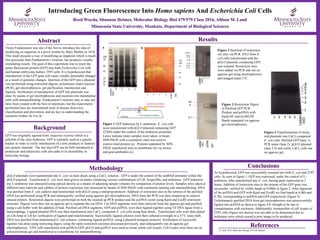
ReedWoyda_Introducing Green Fluorescence Into Homo sapiens And Escherichia Coli Cells
- 1. Reed Woyda, Shannon Helmer, Molecular Biology Biol 479/579 Class 2016, Allison M. Land Minnesota State University, Mankato, Department of Biological Sciences Abstract References Conclusions Victor Frankenstein was one of the first to introduce the idea of modifying an organism in a novel written by Mary Shelley in 1818. This study presents a way of modifying an organism which is much less gruesome than Frankenstein’s creation, but produces visually stimulating results. The goal of this experiment was to insert the green fluorescent protein (GFP) into both Escherichia Coli cells and human embryonic kidney 239T cells. It is hypothesized that introduction of the GFP gene will cause visually detectable changes as a result of genomic changes. Insertion of the GFP into a plasmid was performed using restriction digests, polymerase chain reaction (PCR), gel electrophoresis, gel purification, transfection and ligation. Verification of introduction of GFP into plasmids was done by means of gel electrophoresis and insertion into mammalian cells with immunoblotting. Frankenstein’s monster may or may not have been created with the best of intentions, but the experiments performed here are instrumental tools in disease discovery, classification and prevention, and are key in understanding the mysteries bodies we live in. Background GFP was originally aquired from Aequorea victoria which is a jellyfish of the class hydrozoa. GFP is routinely used as a genetic marker in order to verify introduction of a new products or features into genetic material. The fact that GFP can be both introduced to prokaryote and eukaryotic cells also adds to its desirability in molecular biology. Introducing Green Fluorescence Into Homo sapiens And Escherichia Coli Cells Figure 1 GFP Induction by L-arabinose. E. coli cells were transformed with pGLO plasmid containing GFP (27kD) under the control of the arabinose promoter. Lanes indicate times samples were taken, in hours. SDS-PAGE with a coomassie stain was used to express total protein (a). Proteins separated by SDS- PAGE transferred were to membrane (b) via mouse and goat antibodies (c). c Methodology pGLO plasmids were transformed into E. coli via heat shock using a CaCl2 solution. GFP is under the control of the araBAD promoter within the pGLO plasmid. Transformed E. coli were then grown on plates containing various combinations of LB, Ampicillin, and arabinose. GFP induction my L-arabinose was measured using optical density as a means of adjusting sample volumes for comparison of protein levels. Samples were taken at different time intervals and validity of protein expression was measured by means of SDS-PAGE with coomassie staining and immunobloting. DNA was purified from E. coli cultures and transformed with pGLO using a miniprep protocol. Addition of restriction sites to the termini of the purified DNA was performed using PCR and subsequently verified using agarose gel electrophoresis. DNA from the PCR was then cleaned up to remove unused primers. Restriction digests were performed on both the cleaned up PCR product and the pcDNA vector using KpnI and EcoRI restriction enzymes. Digests were then run on agarose gel to separate the cut DNA. Cut DNA segments were then removed from the agarose gel and purified using a salt buffer with the addition of heat. Purified cut DNA segments, GFP and pcDNA, were then ligated together using T4 DNA ligase from a bacteriophage. Ligated plasmid DNA was then transformed into CaCl2 competent E. coli cells using heat shock. Transformed cells were then plated on LB-Amp or LB for verification of ligation and transformation. Successfully ligated colonies were then cultured overnight in a 37 ̊C water bath. DNA was purified from transformed E. coli cultures, containing ligated pcDNA, using a plasmid miniprep protocol. Verification of successful ligation was done using restricting digest, using the same restriction enzymes discussed previously, and subsequently run on agarose gel electrophoresis. 239T cells transfected with pcDNA-GFP, pGLO and pcDNA were used to create whole cell lysates. Cell lysates were then run on polyacrylamide gel and transferred to a membrane for immunoblotting. Figure 4 Transformation of sticky end plasmids into CaCl2 competent E. coli cells. Purified GFP (lane 1), PCR water (lane 2), pGLO plasmid (lane 3,5) and solely CaCl2 cells run on agarose gel. Figure 3 Restriction Digest of Purified GFP PCR Product and pcDNA with KpnI-HF and EcoRI-HF. Bands separated via agarose gel electrophoresis. a b Figure 2 Insertion of restriction cut sites via PCR. DNA from E. coli cells transformed with the pGLO plasmid, containing GFP, was isolated. Restriction sites were added via PCR and run on agarose gel using electrophoresis and imaged under UV. As hypothesized, GFP was successfully inserted into both E. coli and 239T cells. As seen in figure 1, GFP was expressed, under the control of L- arabinose, after transformed into E. coli, having peak expression at 3 hours. Addition of restriction sites to the termini of the GFP gene was successful, verified by visible bands at 0.08kb in figure 2. After digestion of the pcDNA and GFP with KpnI and EcoRI we find bands at 6.0kb and 0.7kb, corresponding to pcDNA and GFP respectively (figure 3). Unfortunately purified DNA from gel electrophoresis was unsuccessfully ligated into pcDNA as shown in figure 4.0, thought to be due to contamination with nucleases. Additionally, immunoblot of cell lysates of 239T cells (figure not shown) was not able to be determined due to technique error which caused a poor image to be produced. A. Land. 2016. Molecular Biology 479 Lab Manual. Results